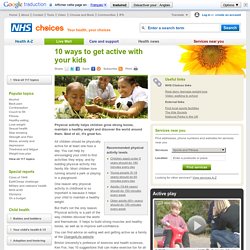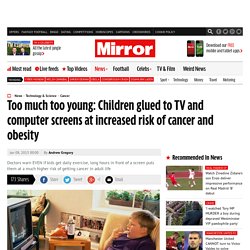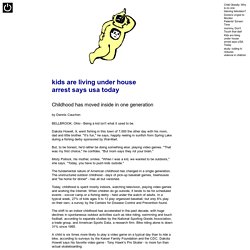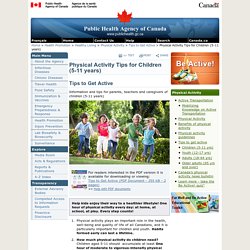

10 tips on getting active with your kids. Physical activity helps children grow strong bones, maintain a healthy weight and discover the world around them.

Best of all, it's great fun. All children should be physically active for at least one hour a day. You can help by encouraging your child to find activities they enjoy, and by building physical activity into family life. Most children love running around a park or playing in a playground. One reason why physical activity in childhood is so important is because it helps your child to maintain a healthy weight. But that's not the only reason. You can find advice on eating well and getting active as a family at the Change4Life website. Bristol University’s professor of exercise and health sciences, Ken Fox, has 10 suggestions that can make exercise fun for all the family. 1. 2. 3. 4. 5. 6. 7. 47 Tips for a Healthier, More Active Family. Activity Finder. Age Appropriate Chores. Cancer and obesity risk warning of sitting in sedentary lifestyle in front of TV and computer screen.
With the sort of technology now available, children are spending more time in front of a screen than ever.

And experts warn that even if youngsters get daily exercise, the increasing hours sat watching TV, playing computer games or surfing the internet could put them at a much higher risk of getting cancer in adult life. Doctors fear long spells of inactivity while glued to a screen may lead to childhood obesity and the associated health dangers. And they are now calling on parents to restrict the amount of time kids watch telly or play computer games to less than two hours a day and delay the age they start allowing toddlers to become viewers. Experts have long been concerned about inactive children and obesity, but the World Cancer Research Fund has issued a fresh warning over kids who exercise and still turn to games and the TV. The charity’s head of health information Kate Mendoza said: “People often assume sedentary behaviour is the same as physical inactivity. Don't Just Sit There! Get Dancing at Home. Kids Are Living Under House Arrest Says USA Today. BELLBROOK, Ohio - Being a kid isn't what it used to be.

Dakota Howell, 9, went fishing in this town of 7,000 the other day with his mom, dad and little brother. "It's fun," he says, happily reeling in sunfish from Spring Lake during a fishing derby sponsored by Wal-Mart. But, to be honest, he'd rather be doing something else: playing video games. "That was my first choice," he confides. "But mom says they rot your brain. " Misty Pollock, his mother, smiles. The fundamental nature of American childhood has changed in a single generation. Today, childhood is spent mostly indoors, watching television, playing video games and working the Internet. The shift to an indoor childhood has accelerated in the past decade, with huge declines in spontaneous outdoor activities such as bike riding, swimming and touch football, according to separate studies by the National Sporting Goods Association, a trade group, and American Sports Data, a research firm.
The change can be seen in children's bodies. New Study Finds Many “Active” Kids Are Actually Couch Potatoes. Hello there!

If you enjoy the content on Obesity Panacea, consider subscribing for future posts via email or RSS feed. Also, don't forget to like us on Facebook! Today’s guest post comes from friend and colleague Dr Katya Herman, and describes her recent paper in the journal Preventive Medicine. This study was done using the QUALITY cohort, which is a very useful dataset for studying the relationships between sedentary behaviour/physical activity and health in the pediatric age group (this is the same dataset that we used for my recent paper on the health impact of breaks in sedentary time). You can find more on Katya at the bottom of this post. Background By now we’ve all heard that being too sedentary isn’t just another way of saying we are inactive – in fact, it is possible to accumulate enough physical activity for health benefits, yet still be too sedentary, depending on what we are doing for the other 23+ hours of our day, referred to as being an “active couch-potato”.
Physical Activity Tips for Children (5-11 years) To share this page just click on the social network icon of your choice.

Information and tips for parents, teachers and caregivers of children (5-11 years) For readers interested in the PDF version it is available for downloading or viewing: Tips to Get Active (PDF Document - 355 KB - 2 pages) >> Help with PDF documents Help kids enjoy their way to a healthier lifestyle! One hour of physical activity every day: at home, at school, at play. Every step counts! Physical activity plays an important role in the health, well-being and quality of life of all Canadians, and it is particularly important for children and youth. Tips to help kids get active Be more active in the after-school time period. Health Benefits Opportunities for socializing Improve fitness Increased concentration Better academic scores Stronger heart, bones and healthier muscles Healthy growth and development Improved self-esteem Better posture and balance Lower stress More physical activity provides health benefits.